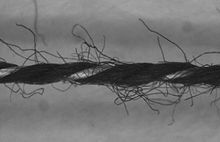sew


When sewing is defined as the joining of materials by a seam . It is one of the oldest handicraft activities that developed early and has played an important role in the course of human history. A large number of different sewing processes have been developed to date.
Today, in DIN 61400, sewing is defined as the process in which one or more threads are repeatedly passed through the sewing material, the threads being intertwined with one another or with the sewing material. Similar techniques, such as needling in tufting or the warp knitting technique (sewing with loop formation) are not called sewing.
Two-dimensional materials can be connected by sewing, especially fabric , leather , paper and cardboard , but also foils and sheets , optionally in combination with one another and for many different purposes. By far the most important field of application for sewing processes is the clothing industry .
In a figurative sense, threadless fabric connections, such as glued seams and weld seams, also count as seams.
General
In the textile and leather goods industry, sewing with sewing machines is now the standard method for joining the individual parts to form a finished product. Even if parts were previously glued together, they usually only get a permanent connection through an additional seam. This can be precisely tailored to the desired properties through the selection of the sewing thread and the corresponding stitch formation.
Seam connections are generally considered to be very stable and resilient. You can connect elastic and inelastic fabrics and thus also different types of materials, e.g. B. leather with fabric or leather with sheet metal . The areas of application are widely spread. When Mali mover driving , a special textile processes, sewing is not used to connect multiple Textile , but to manufacture a textile itself.
Sewing utensils such as buttons , scissors , needles, threader and different colored threads and threads , etc. are often kept in a sewing box .
Number of threads
In the artisan sense, sewing is usually done with a sewing needle and a thread . Sewing machines , on the other hand, usually work with one upper and one lower thread. Special machine types, such as overlock sewing machines , use several needles on one seam at the same time.
Double seams on jeans, overlock seams on knitted fabrics or jersey and the mechanical linking of carpet edges are also made with more than two threads and cover a textile edge to prevent fraying. With some types of seams, such as the fell seam or the French seam , an already sewn connection is folded over again and sewn on with several threads in order to increase durability and / or achieve certain optical effects. By using several threads, the seam connection can be made so stable that the overall load-bearing capacity of the seam exceeds that of the fabric.
The chain stitch is a special form of sewing on a sewing machine . A single thread is crocheted with the material to be processed . Seams made with this process can later be separated again easily by pulling the thread.
Seam shapes

Due to the two-dimensional nature of the fabric, only two types of seam connections can generally be distinguished: overlapped seams and " butt-to-butt " seams. Overlapped sewing is also known as sewing through , and butt-to-butt sewing is also known as sewing on . Sewing can be done one or more times.
Individual evidence